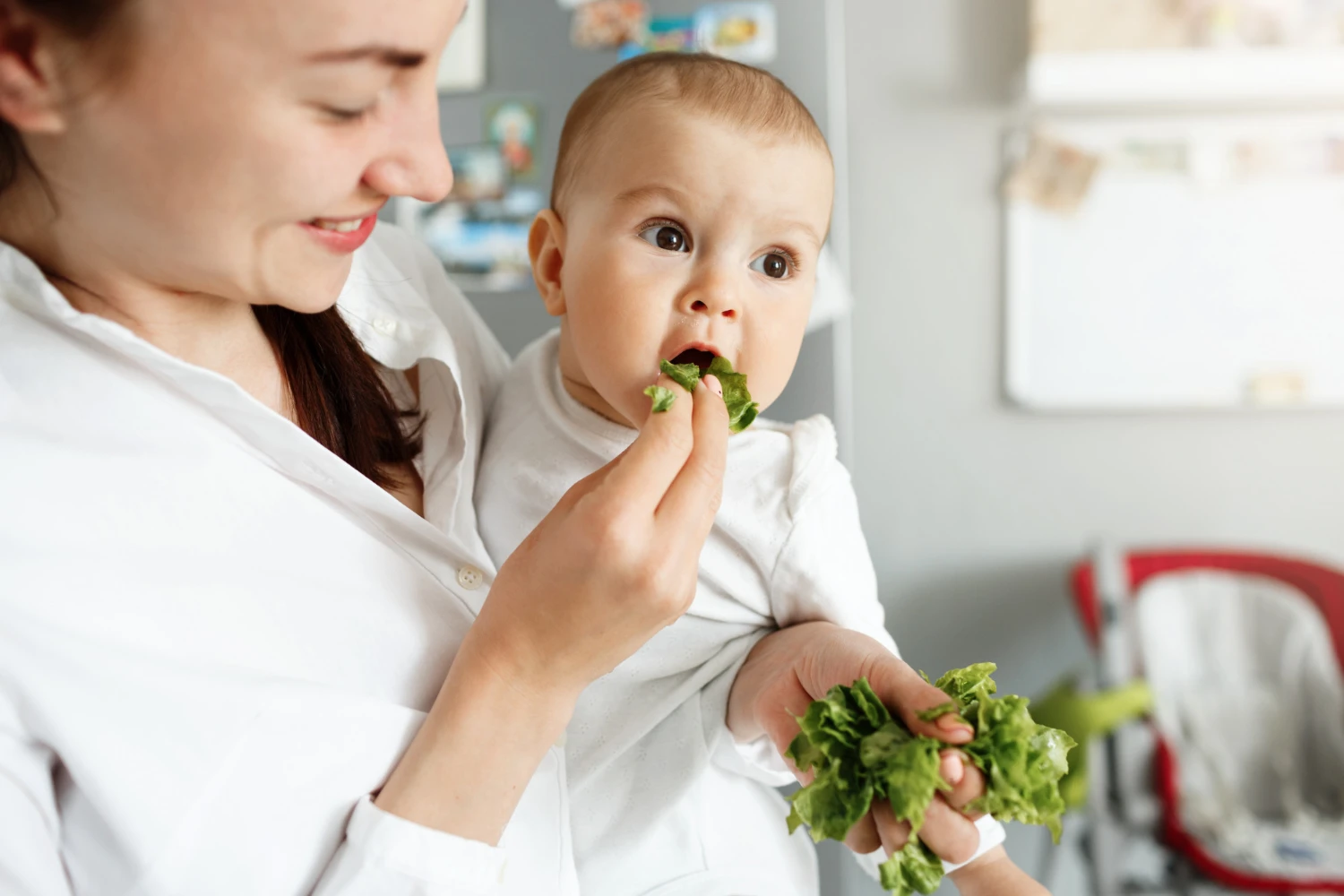When your baby starts breastfeeding, everything seems new to them. However, sometimes certain foods can cause strange reactions. A rash on the cheeks, an upset stomach, or a runny nose after breastfeeding may seem minor, but they could be signs that your baby is allergic to food. Parents often worry because it’s difficult to distinguish between normal irritability and an allergy.
This article explains everything. You’ll learn about the most common food allergies in babies, what symptoms to look out for, and how doctors usually confirm them. We’ll also look at safe ways to manage these allergies, whether your baby is breastfeeding, formula-fed, or just starting solids. Think of this guide as a simple map: no medical jargon, just straightforward steps that will help you recognize symptoms early and take the right action.
What Are Food Allergies in Infants?
Food allergies occur when your baby’s immune system reacts to something in food as if it were harmful. The most common reactions are to proteins in milk, eggs, or peanuts. Instead of accepting these foods, the body produces an allergic reaction.
Food allergies can manifest in different ways:
- Skin reactions like rash or hives
- Digestive problems like vomiting or diarrhea
- Breathing problems like congestion or wheezing
Some allergies are mild, while others can be serious and require immediate medical attention.
Why Food Allergies Are Common in Infants
Babies’ immune and digestive systems are developing, making them more sensitive to proteins in foods. Genetics also plays a role. If parents have allergies, babies are more likely to develop them as well.
The Most Common Food Allergies in Infants
Milk Allergy
Milk allergies, especially those caused by cow’s milk proteins, are the most common. They can occur in both breastfed and formula-fed babies.
The following are the symptoms of milk allergy in babies:
- Red rash or hives
- Diarrhea or blood in stool
- Vomiting after feeds
- Colic or excessive crying
- Nasal congestion
A milk allergy is different from lactose intolerance. Lactose intolerance involves difficulty digesting the sugars in milk, while a milk allergy is an immune reaction to the proteins.
Soy Allergy
Some babies with cow’s milk allergies may also be allergic to soy, making formula selection difficult.
Symptoms of Soy Allergy in Babies:
- Loose stools
- Rash or hives
- Vomiting
- Irritability after feeds
Egg Allergy
Egg allergies are common when eating solid foods. Both the egg white and the yolk can cause allergies.
Signs of egg allergy in infants:
- Rash around the mouth
- Swelling of lips or eyes
- Vomiting or diarrhea
Peanut and Tree Nut Allergy
Peanut allergies often cause more severe reactions than those caused by other foods. Doctors recommend introducing peanuts in safe amounts to reduce the risk, but only with guidance.
Symptoms of Peanut Allergy in Babies:
- Sudden rash or hives
- Swelling of face or lips
- Coughing, wheezing, or difficulty breathing
Wheat Allergy
Some babies are allergic to wheat proteins. This is different from celiac disease, which is an autoimmune condition.
Symptoms of Wheat Allergy in Babies:
- Rash or hives
- Vomiting or bloating
- Loose stools
Fish and Shellfish Allergy
Although it’s less common in infants, some babies are allergic to fish or shellfish proteins. Reactions can be severe, so many parents delay introducing these foods.
Other Allergies Seen in Infants
- Banana allergy: itching, rash, or upset stomach.
- Rice allergy: rare but may cause diarrhea or rash.
- Oat allergy: can appear as rash or digestive problems.
- Nut allergies: besides peanuts, almonds, cashews, or walnuts may also cause reactions.
How to Spot Signs of Food Allergies in Infants
Parents often wonder if fussiness or spitting up is a sign of allergies. Look for patterns. If symptoms appear repeatedly after the same food, it could be an allergy.
Common signs include:
- Skin: hives, eczema, swelling
- Stomach: vomiting, diarrhea, blood in stool, constipation
- Breathing: congestion, coughing, wheezing
- Behavior: unusual crying or irritability after feeding
If symptoms appear suddenly and are severe (such as swelling or trouble breathing), treat it as an emergency and seek immediate help.
Testing for Food Allergies in Infants
Doctors may use:
- Skin prick testing: A small amount of an allergen is placed on the skin to see if there is a reaction.
- Blood test: Checks immune response
- Elimination diet: Removing the suspected food and reintroducing it to confirm the reaction
Parents should avoid guesswork or self-diagnosis. Always consult a pediatrician before eliminating staple foods.
How to Manage Food Allergies in Infants
For Breastfed Infants
- If the baby reacts, the mother may need to eliminate the allergen (such as milk, eggs, or nuts) from her diet.
- Work closely with your doctor to ensure your diet is nutritionally balanced.
For Formula-fed Infants
- If cow’s milk allergy is confirmed, switch to a hypoallergenic formula.
- Soy formula doesn’t always work, as some babies react to soy as well.
For Infants Starting Solids
- Introduce one new food at a time. Wait 3-5 days before introducing another.
- Start with a small amount and monitor for reactions.
Home Care and Medical Care
Mild symptoms can often be treated at home with a doctor’s advice. Severe symptoms require emergency treatment. In rare cases, a doctor may prescribe epinephrine for severe allergic reactions.
Practical tips for parents:
- Read ingredient labels carefully
- Keep a food diary to track reactions
- Inform caregivers and daycare about allergies
- Always consult your pediatrician before making dietary changes.
Can Food Allergies Be Prevented?
Research suggests that introducing allergens like peanuts and eggs early may reduce the risk of allergies. The National Health Service (NHS) recommends introducing these foods to your baby around 6 months of age, while your baby is still breastfeeding. If your baby already has eczema or other allergies, always check with your doctor before introducing high-risk foods.
When to See a Doctor
Call your doctor if:
- Your baby has frequent rashes after feedings
- There’s blood in the stool
- The baby struggles to breathe
- Swelling appears on the face or lips
A quick consultation helps confirm whether it is an allergy or something else.
Conclusion
Food allergies in babies can be stressful, but with the right approach, most cases can be managed. Knowing common allergies and their symptoms helps parents take action quickly and safely. Whether your baby is breastfeeding, formula-fed, or just starting solids, paying attention to reactions and working closely with your doctor will make feeding safer and less stressful.
Frequently Ask Questions (FAQs)
1. What are the most common food allergies in infants?
The most common ones include milk, soy, eggs, peanuts, wheat, fish and tree nuts.
2. How do I know if my baby has a food allergy?
Watch for recurrences such as rashes, vomiting, or diarrhea after the same meal.
3. Can breastfeeding cause food allergies in infants?
Breast milk itself does not cause allergies, but proteins from foods the mother eats can pass into the milk and cause reactions.
4. How are food allergies treated in infants?
By avoiding allergens, changing formulas if necessary, and seeking help from a doctor for nutritional support.
5. Do infants outgrow food allergies?
Many children outgrow milk, egg, and soy allergies by school age. Peanut and nut allergies tend to be more persistent.
6. What’s the difference between food allergy and food intolerance?
Allergies affect the immune system and can cause rashes, swelling, or breathing problems. Intolerances usually only cause stomach upset.
7. Can I prevent food allergies in my baby?
Introducing allergen-causing foods around 6 months of age may help, but consult your doctor first.
8. Should I delay giving peanuts or eggs?
No, experts say that giving them in safe amounts beforehand can reduce the risk of allergies, unless your doctor suggests otherwise.





